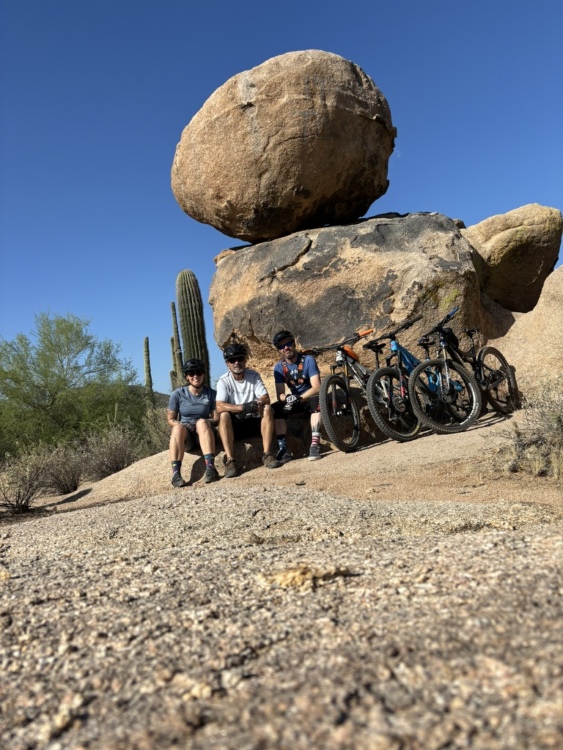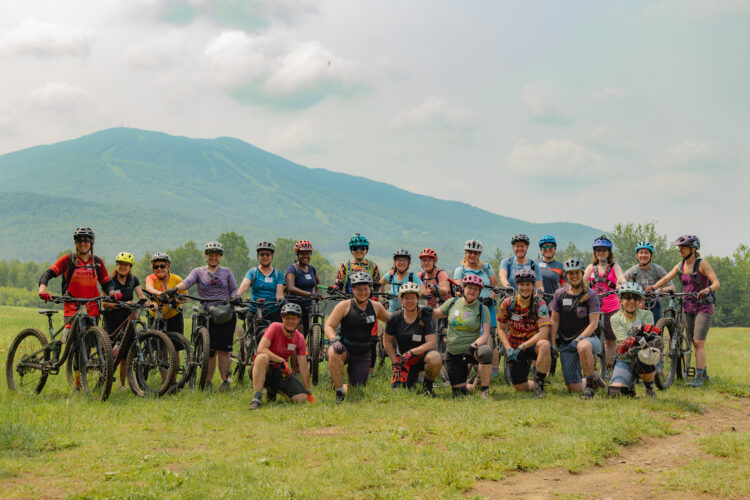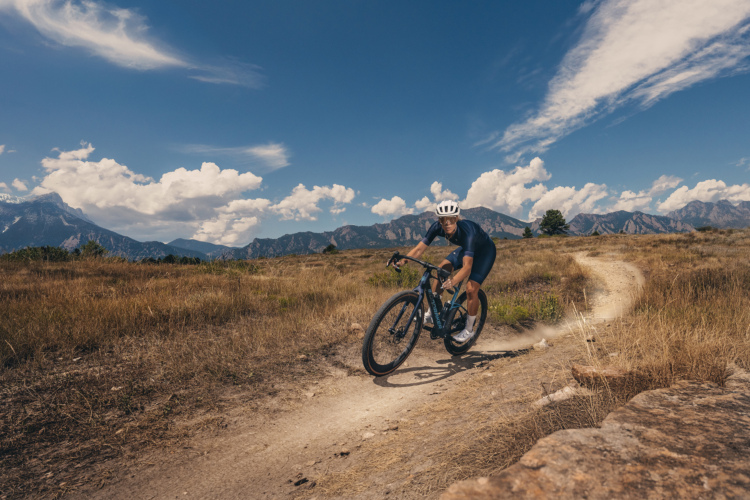
Mountain biking is no doubt a way of living. It is a community that thrives on engaging others, growing friendships, and welcoming newcomers. Though some part of the mountain biking lifestyle is suited for solo couples or roamers, communities exist where kids are groomed to be masters of the dirt. Sometimes, the newcomer is a baby, bringing along a much awaited anticipation of the first Strider ride and two-wheel experience.
When the mother is also a shredder, a lot of unanswered questions certainly pop up as the journey into motherhood unfolds. The medical community and its recommendations are focused on keeping the baby healthy while mom experiences pregnancy, adjusting exercise time and intensity as the pregnancy progresses. Still, the amount of time put into women’s health research is minimal compared to other areas of medicine and sport.
And what about postpartum? There are guidelines published by the American College of Obstetricians and Gynecologists on when an “all clear” should be given by a practitioner to start exercising (depending on type of birth and any complications), or as soon as mom feels ready. Even stated, a lot of rumors and fears float around in abundance among women, creating a sea of uncertainty and anxiety.
What will life be like after my new baby is here? Will I have support? When can I start to exercise, and will I have time to go riding? What if I was a competitive athlete, how slow do I really need to go? Will my community be there for me?
The information presented in this article attempts to provide discussion around many common and uncommon questions that active mothers face after birth, as well as provide recommendations for how to reintegrate mountain biking during the postpartum journey.
For the new mama shredders out there: this is for you!
Maintain realistic expectations. Don’t not exercise. If you can’t exercise for an hour because that is what you’re used to, you’ll never regret 15 minutes on a bike if that’s all you can fit in. Some cycling is better than no cycling. Any exercise will promote foundational benefits related to heart health and fitness, mood, sleep and weight management.
Never underestimate the power of a trainer or stationary bike. Lean on a stationary bike or trainer. Interval or zone training for 20 or 30 minutes can help maintain fitness. It may also prompt you to do things you don’t normally do outside, which can add more robustness to your training schedule and lead to benefits such as improved recovery after hard efforts.


Cross-training has a number of benefits, so don’t write it off. When your baby is old enough to sit up, get a jogging stroller. The cardiovascular aspects of running can help improve fitness related to cycling. It is also a weight-bearing exercise, and therefore has additional benefits, particularly for women. (Cycling isn’t the greatest for maintaining bone mineral density.) Running and strength training both provide benefits to bone mass, aerobic fitness, and can help with weight loss. Strength training is something that can easily be done with the baby and in the house if you have bands or weights. Additionally, many gyms provide daycare for members.
Postpartum mood disorders are very real, but exercise can help. The roller coaster associated with pregnancy doesn’t end after the baby arrives. You climbed the mountain and it took nine months. The journey in the opposite direction honestly takes just as long, and can be equally difficult, though different. Women and their partners are often told to take notice of symptoms related to depression, anxiety, and even rage and anger, because they can be signs of a postpartum mood disorder.
In some cases, these pregnancy-related problems begin during birth (perinatal mood disorders), soon after birth, and in others they do not begin until feedings are dropped (if breastfeeding), around 4-6 months. Symptoms may last through the duration of weaning and after. In any case, if you experience symptoms, please reach out to a doctor. And please remember that it isn’t your fault.
On a positive note, research strongly supports the idea that healthy lifestyle habits like exercise can significantly help treat postpartum depression alongside standard care. A recent meta analysis published in PLOS One has indicated that the positive physiological effects of exercise are even more profound in preventing perinatal mood disorders, and also helps reduce the risk of pregnancy-related complications.
In addition, these mood disorders can be mitigated by providing the mother with adequate support. Her body is feeding the baby, her body is fueling her activity, her body is sleep-deprived and leaching nutrients, and hormones are far from a pre-pregnancy baseline — it is a heavy load to lift. Lean on your cycling community, religious community, family and friends — whatever you have. You would be surprised how many people are willing to help. It is also good for your baby to be integrated into a community that keeps you happy and supports you!
You may experience a tendon or ligament injury (what?!) During pregnancy, the body slowly prepares for birth in many ways, including the production of a special reproductive hormone called relaxin, made by the ovaries and placenta. The main function of relaxin is to literally do what it says — relax the ligaments in preparation for childbirth (though it does impact other things such as playing an important role in balancing glucose metabolism).
Relaxin levels remain high for up to a year postpartum. In the context of sport and exercise, these elevated levels increase the risk for tendon and ligament issues around major joints, including the hip/pelvis, wrist, foot, and knee. I personally suffered from four separate tendon injuries throughout the first eight months postpartum: hip flexor, left knee, foot flexor, and right wrist, the latter of which recurred and is currently ongoing.
There is a thumb and wrist condition that is somewhat common for many women called De Quervain’s tenosynovitis (the condition mentioned that I’ve had twice now). Due to both relaxin’s effects and increased use of the thumb/wrist while feeding and picking up a child (throw in being on phones and shifting a bike), the tendons that attach at the base of the thumb become inflamed, causing pain in the wrist, thumb and sometimes forearm. In prolonged or more severe cases, the tendon can degenerate and use of the thumb can be compromised.
If you feel soft tissue pain while exercising, or experience symptoms of De Quervain’s, follow the RICE method (rest, ice, compression, elevation), and rest the area until it heals. If it doesn’t heal or if you’re concerned, see your doctor or orthopedic surgeon. The body is healing from pregnancy, and also needs time to heal from and prevent injury.


Breastfeeding impacts glucose utilization, so harder efforts may suffer. Mammary glands only use glucose when producing milk. Feeling limited on power and reaching fatigue earlier is not uncommon. Be mindful of fueling before, during, and after exercise. In this season of life, carbs are your friend.
Weight loss takes time, even if you breastfeed. Maintaining weight and a healthy lean body mass to fat ratio is important for athletes (it’s also nice to think about the day when you can stop wearing maternity clothes). Breastfeeding has many, many benefits for both mom and baby, and it is often anticipated that it will also lead to more rapid weight loss as it is ongoing.
What isn’t as commonly discussed, but can be found in online forums, is a seemingly equal number of women discussing the inability to lose weight, or even gaining weight while breastfeeding. There is, of course, a physiological explanation. After birth, the body produces a hormone called prolactin to stimulate milk production, and oxytocin to both stimulate milk’s release and help mom bond with baby. Prolactin also inhibits fat utilization. Couple that with low estrogen levels and a high appetite, and it is no wonder why stepping on a scale may be a cringe-worthy moment.
Regardless of the weight journey, it is important to focus on the following:
- Delivering proper nutrition to the baby takes priority over everything. If breastfeeding, cutting too many calories or excessively exercising to force fat loss may lead to leaching of unnecessary nutrients from the body to create balanced milk if it can’t be derived from food (e.g. calcium will be lost from bone, potentially leading to dental caries; dehydration; excessive fatigue; poor recovery; and/or soft tissue injuries).
- If you are finding it hard to lose weight, do not worry — it will happen once the baby starts to wean. See the previous bullet.
- Remember to focus on a slow reintegration to training, gaining core strength, and overall muscular strength and endurance.
Speaking of weaning, it may be even more important at this time to engage in physical activity to help combat weaning-related symptoms. Many women have an increase in anxiety, insomnia, and depression for weeks until oxytocin and prolactin production stabilize every time a feeding is dropped. Couple that with low estrogen, and hard can become an understatement. Any type of stress relief is beneficial, whether it be mountain biking, hiking, meditation, riding a stationary bike, or even going on a walk, with or without your baby.
Your life is completely different. It will be exciting, lonely, full of love, and exhausting, all in one day. Mental health is extremely important, and your baby’s developing brain is a sponge for learning attachment and safety, so they rely on you for calmness and comfort. Finding a way to fit in exercise a few days a week can make a huge difference in mood and energy levels. Many women who are used to engaging in physical activity on a regular basis lose the ability to do so due to a variety of circumstances. They may not have family or a local community to help, or perhaps they are raising their children on their own. Working out a schedule with a support group, partner, or babysitter is possible and will help keep cycling a part of life, though it may not necessarily be the same.
Here are a few tips that helped me along my postpartum journey.
If you’re breastfeeding, get a mobile pump. I recommend the Momcozy M5 hands-free pump. It is USB rechargeable, and you can go anywhere with it. Bring the pump along with a cooler and ice to store milk while you’re out.
Find a set of flow trails or jump park and bring your little. The fresh air and positive energy are great! My son has accompanied our local ride group to Bean Peaks, an awesome set of flow trails in Prescott, AZ. We take turns hanging out with him while riding laps, and he loves it. Bring a Pack-and-Play and carrier for your kid to hang out in, or go on a walk or hike in the area.
If you can, I recommend a meal prep system, even if occasionally. I used and still use Hungryroot, which has helped me not only maintain a healthy diet but saves time thinking about what food to prepare, and when. My son also enjoys the variety of food. Find a system that fits your budget and dietary needs.
Create a routine around adequate hydration. I am old school when it comes to hydration containers (Nalgene FTW!), but whatever your brand, it should go with you everywhere so you stay hydrated. And do not forget about electrolytes. New research out of the Hydration Science Lab at ASU has shown under-hydration and dehydration impacts mood much more significantly in women. It also impacts breast milk production. And obviously, it impacts performance.
How to find time to ride and exercise
My son exercises with me the majority of the time. There were many days in his infancy where it was hard to get up in the morning, especially when daytime temperatures were over 110 degrees in Arizona and I had a small window of opportunity to work out. I also suffered from postpartum depression and anxiety, which didn’t help. So what did I do?
- Having a Peloton exercise bike was crucial, especially during the summer. He would chill in the Pack and Play long enough for me to get in a solid 20-30 min interval workout.
- I kept him on a pretty routine nap schedule, which made him a good overnight sleeper and his morning wake time (somewhat) predictably between 5:00 and 6:00 am. I did my best to get up before him, get prepared, wake him, feed him, and get out the door. This was really hard at first, but got easier as he got older and slept more at night.
- I hiked if I couldn’t bike or didn’t have any support. I would jog with him in the stroller (and even ran a 5K!), and pull him in the bike trailer when he was old enough (I started this at 11 months).
- Sometimes, I just gave in and listened to my body, and it was what I needed. The bike will be there tomorrow.
If you can’t mountain bike as much as you’d like, I HIGHLY recommend getting a trailer. The Thule Chariot Cross not only functions as a bike trailer, but can also adapt to become a jogging stroller, a walking stroller, and even has a ski attachment. It’s not only robust, but it’s big enough inside to enjoy for many years. Twins? No problem… Thule makes a two-seater.

Bottom line
The takeaways are clear: YOU CAN DO THIS. It is antiquated to think that new moms shouldn’t exercise, can’t, or shouldn’t find the time to fit it in. With some thoughtful scheduling and a support system — whatever that looks like — women riders can enjoy physical activity and the trails after birth, and often get close to where they were prior to having a baby within the first year postpartum. And, some of the best news? You become an ambassador, teaching your little that biking is super fun and adventuresome, setting them up for an appreciation of the glorious outdoors and the sport we love!
Are you a mountain biking new mom? We would love to hear your story in the comments!
Postpartum resources
The Tucson Perinatal Health Coalition provides free resources for mothers experiencing or wanting to learn about postpartum mood disorders.
Postpartum Support International provides free virtual support groups.
If you’re an enrolled veteran, the VA offers women’s health resources such as counseling and mental health clinicians, maternity care, educational courses on postpartum depression and anxiety, and lactation counseling. Veterans can call the Women Veterans Call Center (WVCC) at 855-829-6636, or reach out to the local VA clinic.
Please dial 988 (Suicide and Crisis Lifeline) if you’re experiencing severe mental health symptoms or thoughts of suicide.











2 Comments
Oct 19, 2024
Oct 22, 2024